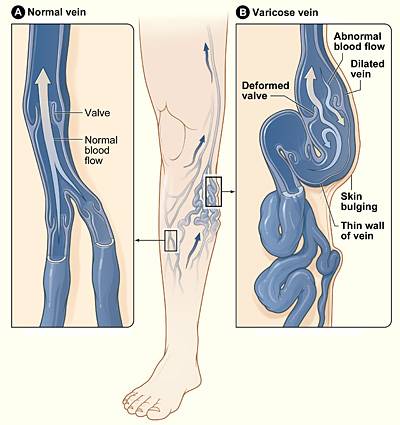Varicose Veins
Varicose veins are a very common condition, which tends to affect people from middle age. They appear as unsightly, enlarged, tortuous veins, just under the skin of the legs.
What Causes Varicose Veins?
 An abnormal communication between the deep and superficial venous systems of the legs appear to be the major factor in the development of varicose veins. In most cases, it begins with the failure of the valve at the sapheno-femoral junction. When this occurs, an uninterrupted column of blood from the heart progressively dilates the veins down the leg, causing them to enlarge and bulge just under the skin. These veins also have one-way valves to prevent blood from flowing backwards. When these valves are faulty, they allow blood to flow backwards, thereby causing blood to pool in the leg.
An abnormal communication between the deep and superficial venous systems of the legs appear to be the major factor in the development of varicose veins. In most cases, it begins with the failure of the valve at the sapheno-femoral junction. When this occurs, an uninterrupted column of blood from the heart progressively dilates the veins down the leg, causing them to enlarge and bulge just under the skin. These veins also have one-way valves to prevent blood from flowing backwards. When these valves are faulty, they allow blood to flow backwards, thereby causing blood to pool in the leg.
Women are affected about 6 times more often than men, with the majority developing during or soon after the second or third pregnancy. In some patients, hereditary factors appear to play a part. Certain conditions, such as obesity and prolonged standing, also increase the likelihood of varicose veins developing.
What Are The Symptoms?
Some patients with varicose veins have no symptoms, other than the veins being unsightly. Others may experience any of the following:
• Aches or heaviness in the legs, especially at the end of the day, or after prolonged walking or standing
• Swelling in the legs
• Nocturnal calf cramps
• Itching of the skin around the varicose veins
More severe symptoms include:
• A buildup of fluid in the superficial tissues of the leg resulting in swelling
• Stasis pigmentation (changes in skin colour around the ankles and lower legs)
• Superficial thrombophlebitis (when inflammation develops in a small vein near the surface of the skin)
• Ulceration
• Bleeding from the varicose veins due to minor injury
How Is It Diagnosed?
Varicose veins are diagnosed based on a good history and detailed physical examination. A duplex ultrasound may be used to determine the exact nature of the reflux and to help locate the position of the damaged valves. This is a non-invasive and painless test, which may be carried out at the doctor's office.
Once this information is available, the surgeon is then able to determine the best treatment option for you.
How Is It Treated?
The general aim in treating varicose veins is to reduce symptoms and prevent complications. For some, the goal may be to improve appearance.
Self-Care At Home:
• Elevate your legs as much as possible. Ideally, your legs should be raised up above the level of the heart to achieve maximum effect.
• Wear compression stockings (eg. Ted stockings). These should be worn the first thing in the morning, before you start walking. Try to keep them on til the end of the day if possible. The downside of wearing these compression stockings in very hot climates such as in Singapore, is that they tend to be very warm and uncomfortable.
• Lose weight if you are overweight.
• Avoid activities which result in straining or bearing down (such as lifting of heavy loads). Conditions which cause straining, such as constipation or chronic coughing, should also be treated and avoided.
• Do not cross your legs when sitting.
• Avoid wearing girdles or belts which are too tight.
Treatment Options:
Treatment may be necessary to remove damaged veins, correct an underlying problem that is causing the varicose veins, as well as to treat complications which may arise. In general, larger varicose veins are treated with surgery (ligation and stripping), endovenous laser, or radiofrequency treatment. Smaller varicose veins and spider veins may be treated with sclerotherapy or laser therapy. In some cases, a combination of treatments may be used.
Image: By National Heart Lung and Blood Institute. (Varicous veins.) [Public domain], via Wikimedia Commons
Further Reading
The article above is meant to provide general information and does not replace a doctor's consultation.
Please see your doctor for professional advice.
